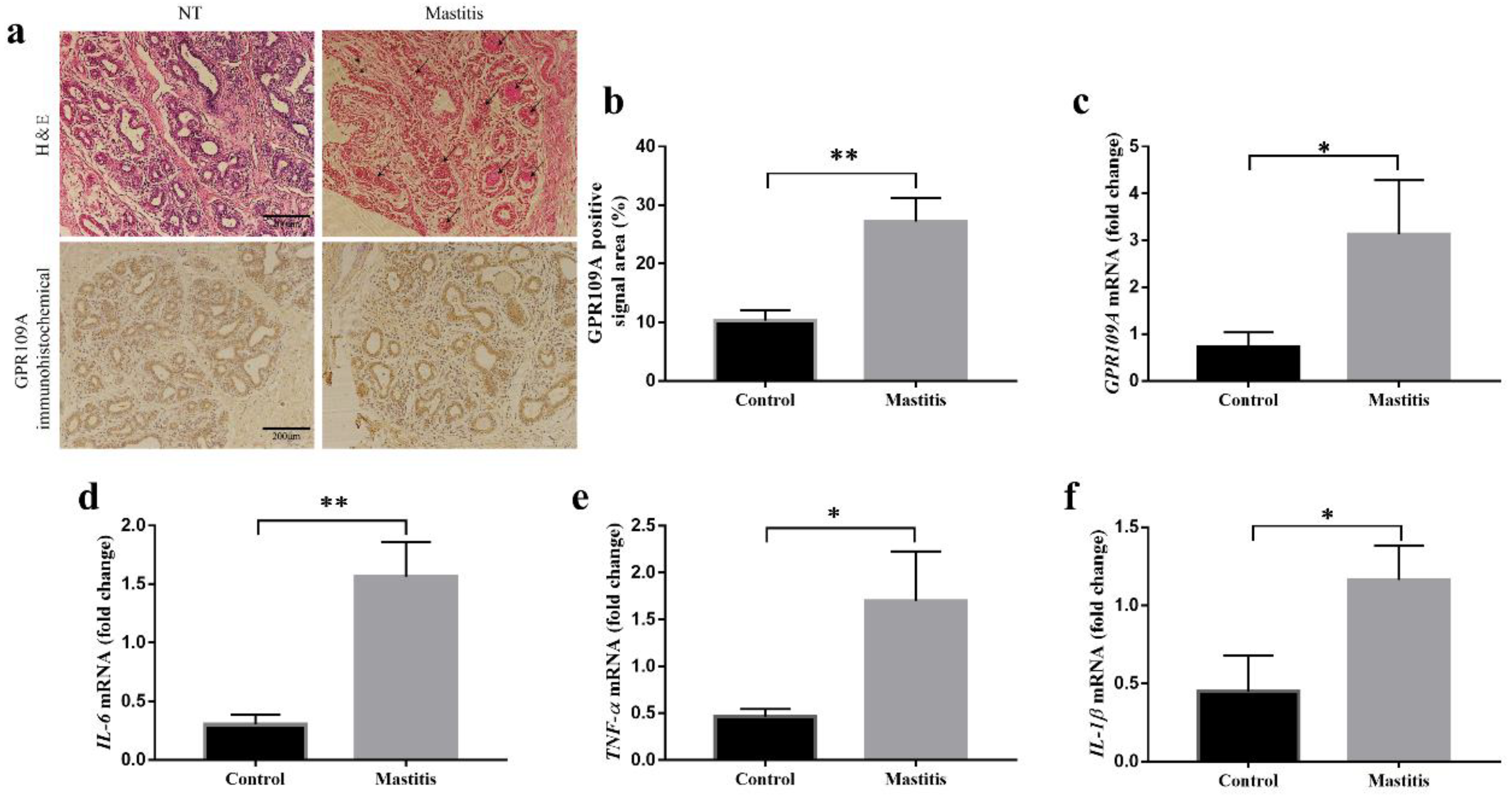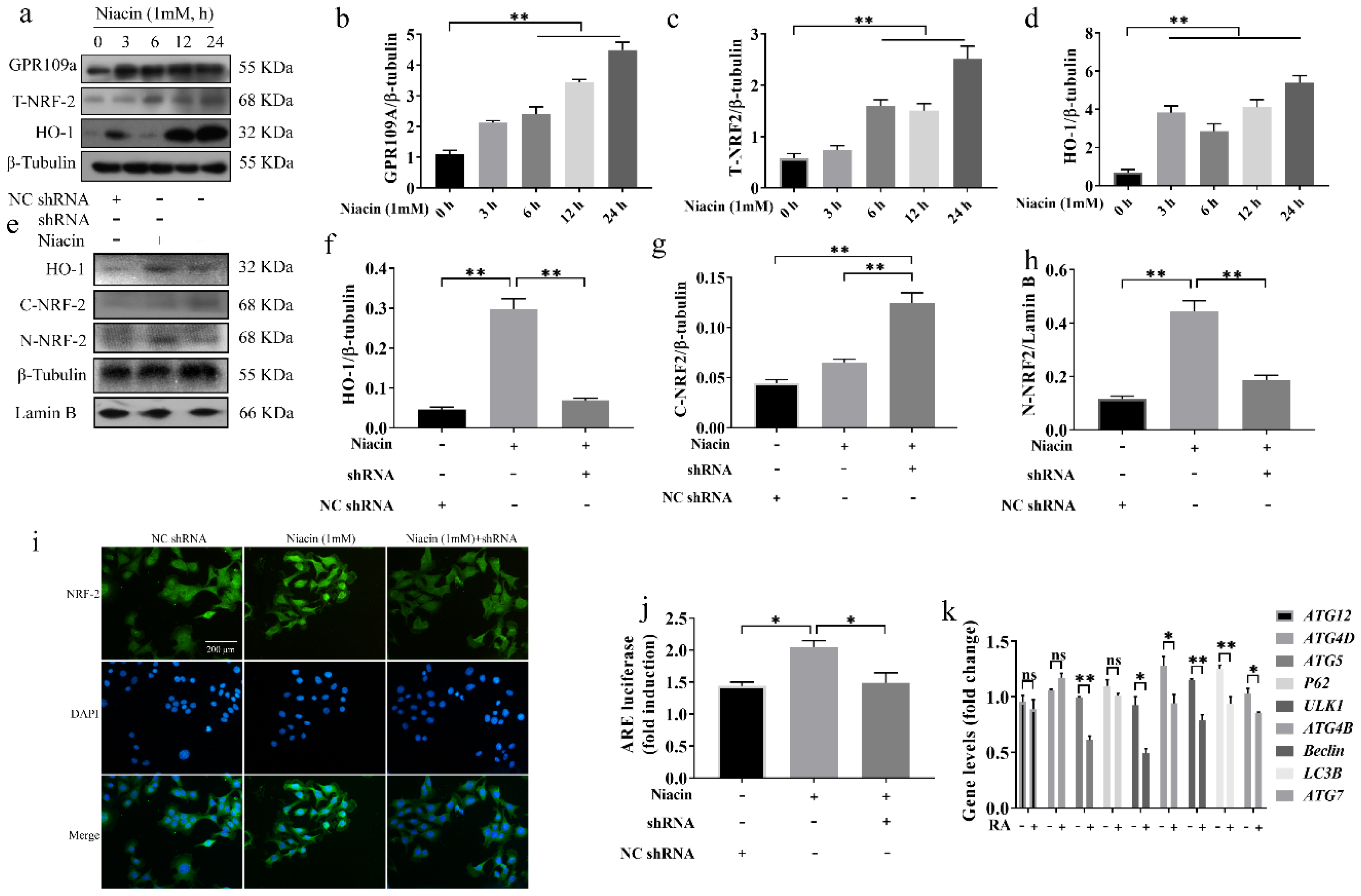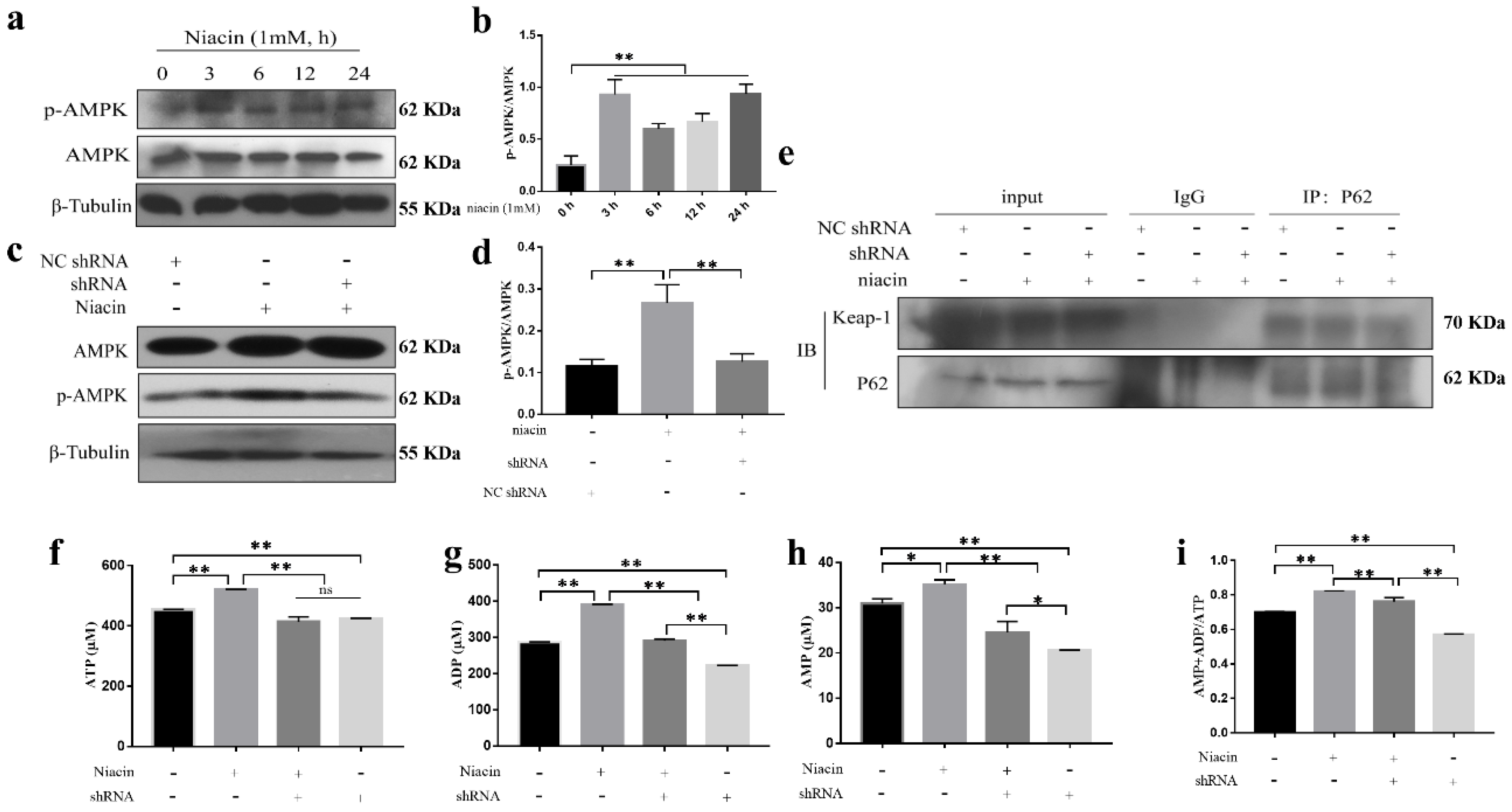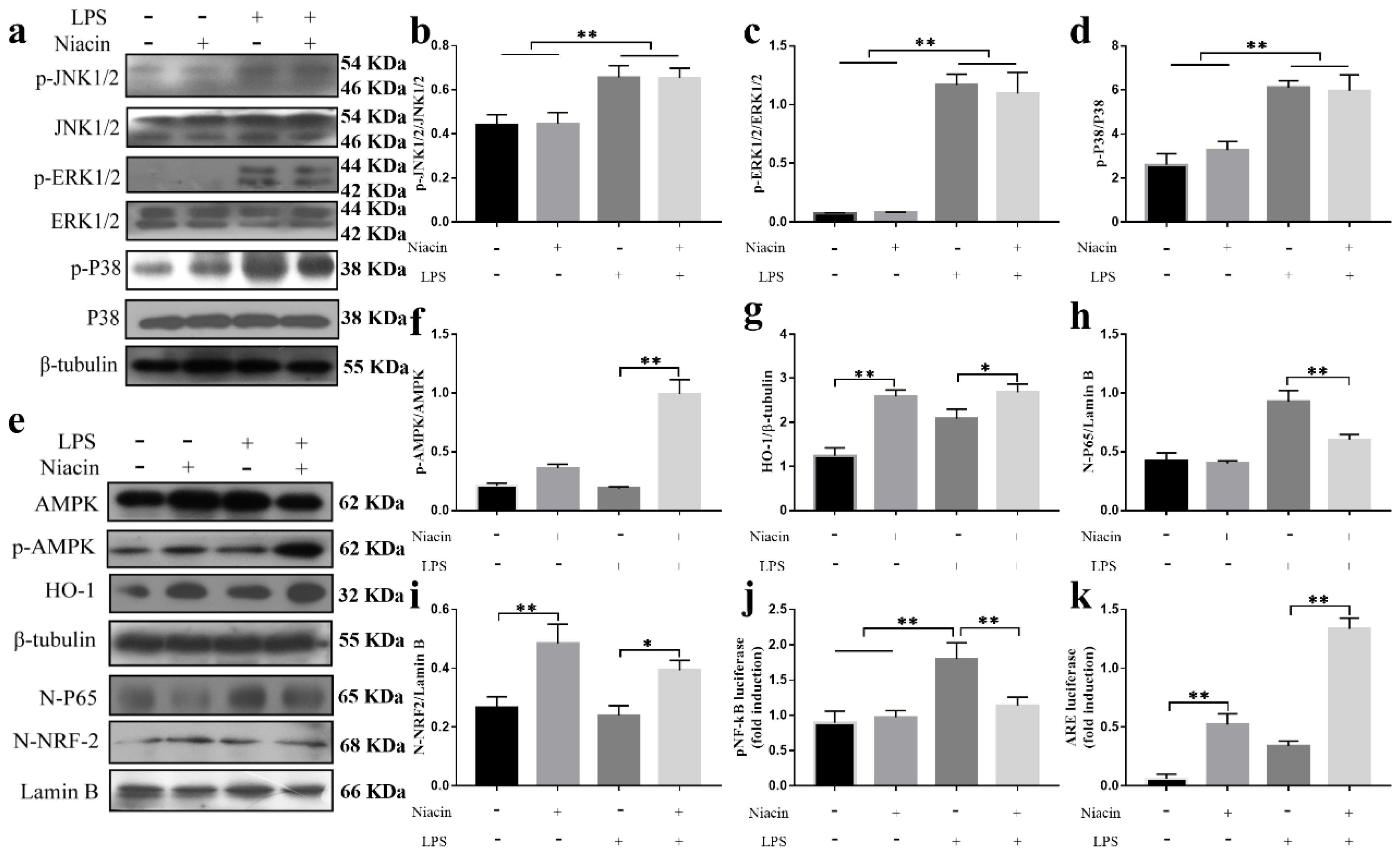Niacin Alleviates Dairy Cow Mastitis by Regulating the GPR109A/AMPK/NRF2 Signaling Pathway
Abstract
1. Introduction
2. Results
2.1. Expression of GPR109A and Pro-Inflammatory Factors in Healthy and Mastitis Dairy Cows
2.2. Activation of GPR109A Inhibits LPS-Induced Inflammatory Response in BMECs
2.3. RA and 3-MA Abolish the Anti-Inflammatory Function of GPR109A in LPS-Induced BMECs
2.4. Activation of GPR109A Promotes Autophagy via the NRF-2 Signalling Pathway in BMECs
2.5. Upregulated GPR109A Activates the NRF-2 Signalling Pathway by Regulating AMPK Signalling and the Interaction between P62 and Keap1 in BMECs
2.6. Activation of GPR109A Enhances the Autophagy in LPS-Induced BMECs
2.7. Activated GPR109A Initiates Signaling through the AMPK/NRF-2/HO-1 Pathway in LPS-Treated BMECs
2.8. Ameliorating the Effect of Activated GPR109A on Mastitis in Dairy Cows
3. Discussion
4. Materials and Methods
4.1. Reagents
4.2. Antibodies
4.3. Animals and Experimental Design
4.4. Plasmid Construction
4.5. ELISA
4.6. Cell Culture
4.7. Separation of Nucleus and Cytoplasm
4.8. Cell Counting Kit-8 Assay
4.9. Real-Time (RT)-PCR
4.10. Reporter Gene Activity of NRF-2/ARE and NF-кB
4.11. Determination of Adenosine Triphosphate (ATP), Adenosine Diphosphate (ADP) and Adenosine Monophosphate (AMP) Levels by High-Performance Liquid Chromatography
4.12. H&E Staining
4.13. Electron Microscopy
4.14. Immunohistochemistry
4.15. Immunofluorescence
4.16. Co-Immunoprecipitation
4.17. Western Blot Analysis
4.18. Statistical Analysis
Supplementary Materials
Author Contributions
Funding
Conflicts of Interest
References
- Kromker, V.; Leimbach, S. Mastitis treatment-Reduction in antibiotic usage in dairy cows. Reprod. Domest. Anim. Zuchthyg. 2017, 52 (Suppl. S3), 21–29. [Google Scholar] [CrossRef] [PubMed]
- Seegers, H.; Fourichon, C.; Beaudeau, F. Production effects related to mastitis and mastitis economics in dairy cattle herds. Vet. Res. 2003, 34, 475–491. [Google Scholar] [CrossRef] [PubMed]
- Detilleux, J.; Kastelic, J.P.; Barkema, H.W. Mediation analysis to estimate direct and indirect milk losses due to clinical mastitis in dairy cattle. Prev. Vet. Med. 2015, 118, 449–456. [Google Scholar] [CrossRef][Green Version]
- Xue, T.; Yu, L.; Shang, F.; Li, W.; Zhang, M.; Ni, J.; Chen, X. Short communication: The role of autoinducer 2 (AI-2) on antibiotic resistance regulation in an Escherichia coli strain isolated from a dairy cow with mastitis. J. Dairy Sci. 2016, 99, 4693–4698. [Google Scholar] [CrossRef] [PubMed]
- Yu, L.; Shang, F.; Chen, X.; Ni, J.; Yu, L.; Zhang, M.; Sun, D.; Xue, T. The anti-biofilm effect of silver-nanoparticle-decorated quercetin nanoparticles on a multi-drug resistant Escherichia coli strain isolated from a dairy cow with mastitis. PeerJ 2018, 6, e5711. [Google Scholar] [CrossRef] [PubMed]
- Kayagaki, N.; Wong, M.T.; Stowe, I.B.; Ramani, S.R.; Gonzalez, L.C.; Akashi-Takamura, S.; Miyake, K.; Zhang, J.; Lee, W.P.; Muszynski, A.; et al. Noncanonical inflammasome activation by intracellular LPS independent of TLR4. Science 2013, 341, 1246–1249. [Google Scholar] [CrossRef] [PubMed]
- Pfalzgraff, A.; Heinbockel, L.; Su, Q.; Brandenburg, K.; Weindl, G. Synthetic anti-endotoxin peptides inhibit cytoplasmic LPS-mediated responses. Biochem. Pharmacol. 2017, 140, 64–72. [Google Scholar] [CrossRef]
- Zhang, H.X.; Liu, S.J.; Tang, X.L.; Duan, G.L.; Ni, X.; Zhu, X.Y.; Liu, Y.J.; Wang, C.N. H2S Attenuates LPS-Induced Acute Lung Injury by Reducing Oxidative/Nitrative Stress and Inflammation. Cell. Physiol. Biochem. 2016, 40, 1603–1612. [Google Scholar] [CrossRef]
- Cheng, L.; Ren, Y.; Lin, D.; Peng, S.; Zhong, B.; Ma, Z. The Anti-Inflammatory Properties of Citrus wilsonii Tanaka Extract in LPS-Induced RAW 264.7 and Primary Mouse Bone Marrow-Derived Dendritic Cells. Molecules 2017, 22, 1213. [Google Scholar] [CrossRef]
- Gong, Q.; Li, Y.; Ma, H.; Guo, W.; Kan, X.; Xu, D.; Liu, J.; Fu, S. Peiminine Protects against Lipopolysaccharide-Induced Mastitis by Inhibiting the AKT/NF-kappaB, ERK1/2 and p38 Signaling Pathways. Int. J. Mol. Sci. 2018, 19, 2637. [Google Scholar] [CrossRef]
- Ning, L.T.; Dong, G.Z.; Ao, C.; Zhang, D.G.; Erdene, K.; Zhang, F.Q.; Wen, J.; Zhang, T.L. Effects of continuous low dose infusion of lipopolysaccharide on inflammatory responses, milk production and milk quality in dairy cows. J. Anim. Physiol. Anim. Nutr. 2018, 102, e262–e269. [Google Scholar] [CrossRef] [PubMed]
- Zhang, K.; Chang, G.; Xu, T.; Xu, L.; Guo, J.; Jin, D.; Shen, X. Lipopolysaccharide derived from the digestive tract activates inflammatory gene expression and inhibits casein synthesis in the mammary glands of lactating dairy cows. Oncotarget 2016, 7, 9652–9665. [Google Scholar] [CrossRef] [PubMed]
- Liu, L.; Zhang, L.I.; Lin, Y.E.; Bian, Y.; Gao, X.; Qu, B.O.; Li, Q. 14-3-3gamma regulates cell viability and milk fat synthesis in lipopolysaccharide-induced dairy cow mammary epithelial cells. Exp. Ther. Med. 2016, 11, 1279–1287. [Google Scholar] [CrossRef] [PubMed]
- Gasparrini, M.; Afrin, S.; Forbes-Hernández, T.Y.; Cianciosi, D.; Reboredo-Rodriguez, P.; Amici, A.; Battino, M.; Giampieri, F. Protective effects of Manuka honey on LPS-treated RAW 264.7 macrophages. Part 2: Control of oxidative stress induced damage, increase of antioxidant enzyme activities and attenuation of inflammation. Food Chem. Toxicol. 2018, 120, 578–587. [Google Scholar] [CrossRef] [PubMed]
- Deretic, V.; Levine, B. Autophagy balances inflammation in innate immunity. Autophagy 2018, 14, 243–251. [Google Scholar] [CrossRef]
- Singh, N.; Gurav, A.; Sivaprakasam, S.; Brady, E.; Padia, R.; Shi, H.; Thangaraju, M.; Prasad, P.D.; Manicassamy, S.; Munn, D.H.; et al. Activation of Gpr109a, receptor for niacin and the commensal metabolite butyrate, suppresses colonic inflammation and carcinogenesis. Immunity 2014, 40, 128–139. [Google Scholar] [CrossRef]
- Wu, B.J.; Chen, K.; Barter, P.J.; Rye, K.A. Niacin inhibits vascular inflammation via the induction of heme oxygenase-1. Circulation 2012, 125, 150–158. [Google Scholar] [CrossRef]
- Soga, T.; Kamohara, M.; Takasaki, J.; Matsumoto, S.; Saito, T.; Ohishi, T.; Hiyama, H.; Matsuo, A.; Matsushime, H.; Furuichi, K. Molecular identification of nicotinic acid receptor. Biochem. Biophys. Res. Commun. 2003, 303, 364–369. [Google Scholar] [CrossRef]
- Tunaru, S.; Kero, J.; Schaub, A.; Wufka, C.; Blaukat, A.; Pfeffer, K.; Offermanns, S. PUMA-G and HM74 are receptors for nicotinic acid and mediate its anti-lipolytic effect. Nat. Med. 2003, 9, 352–355. [Google Scholar] [CrossRef]
- Wise, A.; Foord, S.M.; Fraser, N.J.; Barnes, A.A.; Elshourbagy, N.; Eilert, M.; Ignar, D.M.; Murdock, P.R.; Steplewski, K.; Green, A.; et al. Molecular identification of high and low affinity receptors for nicotinic acid. J. Biol. Chem. 2003, 278, 9869–9874. [Google Scholar] [CrossRef] [PubMed]
- Fu, S.P.; Wang, J.F.; Xue, W.J.; Liu, H.M.; Liu, B.R.; Zeng, Y.L.; Li, S.N.; Huang, B.X.; Lv, Q.K.; Wang, W.; et al. Anti-inflammatory effects of BHBA in both in vivo and in vitro Parkinson’s disease models are mediated by GPR109A-dependent mechanisms. J. Neuroinflamm. 2015, 12, 9. [Google Scholar] [CrossRef]
- Li, Z.; Li, X.; Lin, S.; Chen, Y.; Ma, S.; Fu, Y.; Wei, C.; Xu, W. Nicotinic Acid Receptor GPR109A Exerts Anti-Inflammatory Effects Through Inhibiting the Akt/mTOR Signaling Pathway in MIN6 Pancreatic beta cells. Ann. Clin. Lab. Sci. 2017, 47, 729–737. [Google Scholar]
- Offermanns, S. Hydroxy-Carboxylic Acid Receptor Actions in Metabolism. Trends Endocrinol. Metab. 2017, 28, 227–236. [Google Scholar] [CrossRef] [PubMed]
- Elangovan, S.; Pathania, R.; Ramachandran, S.; Ananth, S.; Padia, R.N.; Lan, L.; Singh, N.; Martin, P.M.; Hawthorn, L.; Prasad, P.D.; et al. The niacin/butyrate receptor GPR109A suppresses mammary tumorigenesis by inhibiting cell survival. Cancer Res. 2014, 74, 1166–1178. [Google Scholar] [CrossRef] [PubMed]
- He, Y.; She, H.; Zhang, T.; Xu, H.; Cheng, L.; Yepes, M.; Zhao, Y.; Mao, Z. p38 MAPK inhibits autophagy and promotes microglial inflammatory responses by phosphorylating ULK1. J. Cell Biol. 2018, 217, 315–328. [Google Scholar] [CrossRef] [PubMed]
- Zhou, Y.Y.; Li, Y.; Jiang, W.Q.; Zhou, L.F. MAPK/JNK signalling: A potential autophagy regulation pathway. Biosci. Rep. 2015, 35. [Google Scholar] [CrossRef]
- Chen, D.; Wu, X.; Zheng, J.; Dai, R.; Mo, Z.; Munir, F.; Ni, X.; Shan, Y. Autophagy regulates proliferation and biliary differentiation of hepatic oval cells via the MAPK/ERK signaling pathway. Mol. Med. Rep. 2018, 17, 2565–2571. [Google Scholar] [CrossRef]
- Burvenich, C.; Van Merris, V.; Mehrzad, J.; Diez-Fraile, A.; Duchateau, L. Severity of E. coli mastitis is mainly determined by cow factors. Vet. Res. 2003, 34, 521–564. [Google Scholar] [CrossRef]
- Yu, G.M.; Kubota, H.; Okita, M.; Maeda, T. The anti-inflammatory and antioxidant effects of melatonin on LPS-stimulated bovine mammary epithelial cells. PLoS ONE 2017, 12, e0178525. [Google Scholar] [CrossRef]
- Bhatt, B.; Zeng, P.; Zhu, H.; Sivaprakasam, S.; Li, S.; Xiao, H.; Dong, L.; Shiao, P.; Kolhe, R.; Patel, N.; et al. Gpr109a Limits Microbiota-Induced IL-23 Production To Constrain ILC3-Mediated Colonic Inflammation. J. Immunol. 2018, 200, 2905–2914. [Google Scholar] [CrossRef]
- Kobayashi, M.; Mikami, D.; Kimura, H.; Kamiyama, K.; Morikawa, Y.; Yokoi, S.; Kasuno, K.; Takahashi, N.; Taniguchi, T.; Iwano, M. Short-chain fatty acids, GPR41 and GPR43 ligands, inhibit TNF-alpha-induced MCP-1 expression by modulating p38 and JNK signaling pathways in human renal cortical epithelial cells. Biochem. Biophys. Res. Commun. 2017, 486, 499–505. [Google Scholar] [CrossRef] [PubMed]
- Ang, Z.; Ding, J.L. GPR41 and GPR43 in Obesity and Inflammation—Protective or Causative? Front. Immunol. 2016, 7, 28. [Google Scholar] [CrossRef] [PubMed]
- Kostylina, G.; Simon, D.; Fey, M.F.; Yousefi, S.; Simon, H.U. Neutrophil apoptosis mediated by nicotinic acid receptors (GPR109A). Cell Death Differ. 2008, 15, 134–142. [Google Scholar] [CrossRef] [PubMed]
- Almquist, J.; Hovdal, D.; Ahlstrom, C.; Fjellstrom, O.; Gennemark, P.; Sundqvist, M. Overexpressing cell systems are a competitive option to primary adipocytes when predicting in vivo potency of dual GPR81/GPR109A agonists. Eur. J. Pharm. Sci. 2018, 114, 155–165. [Google Scholar] [CrossRef]
- Chen, G.; Ran, X.; Li, B.; Li, Y.; He, D.; Huang, B.; Fu, S.; Liu, J.; Wang, W. Sodium Butyrate Inhibits Inflammation and Maintains Epithelium Barrier Integrity in a TNBS-induced Inflammatory Bowel Disease Mice Model. EBioMedicine 2018, 30, 317–325. [Google Scholar] [CrossRef]
- Wang, Y.; Zhang, J.; Huang, Z.H.; Huang, X.H.; Zheng, W.B.; Yin, X.F.; Li, Y.L.; Li, B.; He, Q.Y. Isodeoxyelephantopin induces protective autophagy in lung cancer cells via Nrf2-p62-keap1 feedback loop. Cell Death Dis. 2017, 8, e2876. [Google Scholar] [CrossRef]
- Xiong, J.; Wang, K.; Yuan, C.; Xing, R.; Ni, J.; Hu, G.; Chen, F.; Wang, X. Luteolin protects mice from severe acute pancreatitis by exerting HO-1-mediated anti-inflammatory and antioxidant effects. Int. J. Mol. Med. 2017, 39, 113–125. [Google Scholar] [CrossRef]
- Kimura, T.; Isaka, Y.; Yoshimori, T. Autophagy and kidney inflammation. Autophagy 2017, 13, 997–1003. [Google Scholar] [CrossRef]
- Marta, P.; Natalia, J.M.; García-Yagüe, Á.J.; Maribel, E.; De, C.M.L.; Fred, V.L.; Alberto, R.; Masayuki, Y.; Rojo, A.I.; Antonio, C. Transcription factor NFE2L2/NRF2 is a regulator of macroautophagy genes. Autophagy 2016, 12, 1902–1916. [Google Scholar]
- Liu, Q.; Lv, H.; Wen, Z.; Ci, X.; Peng, L. Isoliquiritigenin Activates Nuclear Factor Erythroid-2 Related Factor 2 to Suppress the NOD-Like Receptor Protein 3 Inflammasome and Inhibits the NF-kappaB Pathway in Macrophages and in Acute Lung Injury. Front. Immunol. 2017, 8, 1518. [Google Scholar] [CrossRef]
- Jiang, T.; Harder, B.; Rojo de la Vega, M.; Wong, P.K.; Chapman, E.; Zhang, D.D. p62 links autophagy and Nrf2 signaling. Free Radic. Biol. Med. 2015, 88, 199–204. [Google Scholar] [CrossRef]
- Kayano, M.; Itoh, M.; Kusaba, N.; Hayashiguchi, O.; Kida, K.; Tanaka, Y.; Kawamoto, K.; Grohn, Y.T. Associations of the first occurrence of pathogen-specific clinical mastitis with milk yield and milk composition in dairy cows. J. Dairy Res. 2018, 85, 309–316. [Google Scholar] [CrossRef] [PubMed]
- Horner, J.L.; Coppock, C.E.; Schelling, G.T.; Labore, J.M.; Nave, D.H. Influence of niacin and whole cottonseed on intake, milk yield and composition, and systemic responses of dairy cows. J. Dairy Sci. 1986, 69, 3087–3093. [Google Scholar] [CrossRef]
- Wu, N.C.; Wang, J.J. Niacin Pretreatment Attenuates Lung Ischemia and Reperfusion-Induced Pulmonary Barrier Function Impairment by Reducing Oxidative Stress and Activating SIRT1 in an Isolated-Perfused Rat Lung Model. Transplant. Proc. 2018, 50, 2834–2838. [Google Scholar] [CrossRef] [PubMed]
- Godden, S.M.; Royster, E.; Timmerman, J.; Rapnicki, P.; Green, H. Evaluation of an automated milk leukocyte differential test and the California Mastitis Test for detecting intramammary infection in early- and late-lactation quarters and cows. J. Dairy Sci. 2017, 100, 6527–6544. [Google Scholar] [CrossRef]
- Zeitz, J.O.; Weber, A.; Most, E.; Windisch, W.; Bolduan, C.; Geyer, J.; Romberg, F.J.; Koch, C.; Eder, K. Effects of supplementing rumen-protected niacin on fiber composition and metabolism of skeletal muscle in dairy cows during early lactation. J. Dairy Sci. 2018, 101, 8004–8020. [Google Scholar] [CrossRef] [PubMed]
- Guo, W.J.; Zhen, L.; Zhang, J.X.; Lian, S.; Si, H.F.; Guo, J.R.; Yang, H.M. Effect of feeding Rumen-protected capsule containing niacin, K2SO4, vitamin C, and gamma-aminobutyric acid on heat stress and performance of dairy cows. J. Therm. Biol. 2017, 69, 249–253. [Google Scholar] [CrossRef]
- Zhao, K.; Liu, H.Y.; Zhou, M.M.; Liu, J.X. Establishment and characterization of a lactating bovine mammary epithelial cell model for the study of milk synthesis. Cell Biol. Int. 2010, 34, 717–721. [Google Scholar] [CrossRef]
- Antalis, T.M.; Godbolt, D. Isolation of intact nuclei from hematopoietic cell types. Nucleic Acids Res. 1991, 19, 4301. [Google Scholar] [CrossRef]
- Giri, B.; Belanger, K.; Seamon, M.; Bradley, E.; Purohit, S.; Chong, R.; Morgan, J.C.; Baban, B.; Wakade, C. Niacin Ameliorates Neuro-Inflammation in Parkinson’s Disease via GPR109A. Int. J. Mol. Sci. 2019, 20, 4559. [Google Scholar] [CrossRef]
- Guo, W.; Liu, B.; Yin, Y.; Kan, X.; Gong, Q.; Li, Y.; Cao, Y.; Wang, J.; Xu, D.; Ma, H.; et al. Licochalcone A Protects the Blood-Milk Barrier Integrity and Relieves the Inflammatory Response in LPS-Induced Mastitis. Front. Immunol. 2019, 10, 287. [Google Scholar] [CrossRef] [PubMed]
- Zhang, C.S.; Hawley, S.A.; Zong, Y.; Li, M.; Wang, Z.; Gray, A.; Ma, T.; Cui, J.; Feng, J.W.; Zhu, M.; et al. Fructose-1,6-bisphosphate and aldolase mediate glucose sensing by AMPK. Nature 2017, 548, 112–116. [Google Scholar] [CrossRef] [PubMed]
- Pizarro, T.T.; Arseneau, K.O.; Bamias, G.; Cominelli, F. Mouse models for the study of Crohn’s disease. Trends Mol. Med. 2003, 9, 218–222. [Google Scholar] [CrossRef]






| Gene | Primer Sequence | |
|---|---|---|
| GPR109A | Forward | 5′-ACCTCGTTCCCCGAACCTTG-3′ |
| Reverse | 5′-CGGCAGCACTTTGGCAATGA-3′ | |
| TNF-α | Forward | 5′-ACGGGCTTTACCTCATCTACTC-3′ |
| Reverse | 5′-GCTCTTGATGGCAGACAGG-3′ | |
| IL-6 | Forward | 5′-ATGCTTCCAATCTGGGTTC-3′ |
| Reverse | 5′-TGAGGATAATCTTTGCGTTC-3′ | |
| IL-1β | Forward | 5′-AGGTGGTGTCGGTCATCGT-3′ |
| Reverse | 5′-GCTCTCTGTCCTGGAGTTTGC-3′ | |
| β-actin | Forward | 5′-TCACCAACTGGGACGACA-3′ |
| Reverse | 5′-GCATACAGGGACAGCACA-3′ | |
| ATG4B | Forward | 5′-AGGTGGACGCAGCGGAAGAG-3′ |
| Reverse | 5′GACAGCCAGCTTCTTGAGGACTTG-3′ | |
| Beclin | Forward | 5′-TGCACAGACACTCTCCTAGACCAG-3′ |
| Reverse | 5′-ATCAGCCTCTCCTCCTCTAATGCC-3′ | |
| ATG12 | Forward | 5′-AAGATGGCTGAGGAGCAGGAGTC-3′ |
| Reverse | 5′-GGAGACCTCGGTAGGCACTTCAG-3′ | |
| ATG7 | Forward | 5′-AAGGTTGTGTCTGCCAAGTGTCTG-3′ |
| Reverse | 5′-TTGTCCACGAACGTGATGTGTCTG-3′ | |
| LC3B | Forward | 5′-GCAGGCCACCGTTCACTCTTG-3′ |
| Reverse | 5′-ATGCAGCAGGAAGAGCAGATTGG-3′ | |
| ATG4D | Forward | 5′-GGCTGAATGGAAGTCCGTGGTC-3′ |
| Reverse | 5′-GTAGCCGATGAAGTACAGCGAGTG-3′ | |
| ATG5 | Forward | 5′-AGCATCATCCCGCAACCAAC-3′ |
| Reverse | 5′-GACCAGCCCTAGTGCCCTTA-3′ | |
| P62 | Forward | 5′-GTGATCTGTGACGGCTGTAACGG-3′ |
| Reverse | 5′-AGGCGGAGCATAGGTCGTAGTC-3′ | |
| ULK1 | Forward | 5′-GCATCGGCACCATCGTGTACC-3′ |
| Reverse | 5′-GGACCAGCGTCTTGTTCTTCTCG-3′ |
© 2020 by the authors. Licensee MDPI, Basel, Switzerland. This article is an open access article distributed under the terms and conditions of the Creative Commons Attribution (CC BY) license (http://creativecommons.org/licenses/by/4.0/).
Share and Cite
Guo, W.; Liu, J.; Li, W.; Ma, H.; Gong, Q.; Kan, X.; Cao, Y.; Wang, J.; Fu, S. Niacin Alleviates Dairy Cow Mastitis by Regulating the GPR109A/AMPK/NRF2 Signaling Pathway. Int. J. Mol. Sci. 2020, 21, 3321. https://doi.org/10.3390/ijms21093321
Guo W, Liu J, Li W, Ma H, Gong Q, Kan X, Cao Y, Wang J, Fu S. Niacin Alleviates Dairy Cow Mastitis by Regulating the GPR109A/AMPK/NRF2 Signaling Pathway. International Journal of Molecular Sciences. 2020; 21(9):3321. https://doi.org/10.3390/ijms21093321
Chicago/Turabian StyleGuo, Wenjin, Juxiong Liu, Wen Li, He Ma, Qian Gong, Xingchi Kan, Yu Cao, Jianfa Wang, and Shoupeng Fu. 2020. "Niacin Alleviates Dairy Cow Mastitis by Regulating the GPR109A/AMPK/NRF2 Signaling Pathway" International Journal of Molecular Sciences 21, no. 9: 3321. https://doi.org/10.3390/ijms21093321
APA StyleGuo, W., Liu, J., Li, W., Ma, H., Gong, Q., Kan, X., Cao, Y., Wang, J., & Fu, S. (2020). Niacin Alleviates Dairy Cow Mastitis by Regulating the GPR109A/AMPK/NRF2 Signaling Pathway. International Journal of Molecular Sciences, 21(9), 3321. https://doi.org/10.3390/ijms21093321






